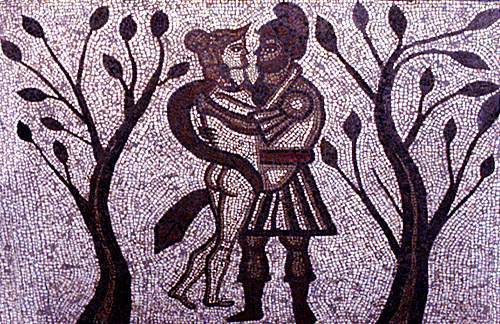"Each of the characters that Aeneas encounters represents an aspect of his self," I deadpan. The room is as silent as the banks of the Styx - that is, I can hear ghostly groans despite the stifling atmosphere. "When Dido confronts the Trojan, she is really a manifestation of his sexual desire, and another thing that he must overcome on his path towards self-realisation."
I ignore the first question - the perennial favourite. "Is this going to be in the exam?" I am waiting for the inevitable second.
"How do you know that Virgil intended this?"
I shuffle my notes. I have the answer to this one. "You don't, and there is no way to find out. In fact, that's irrelevant. Mythology is a language, and it has its own meanings that the author cannot understand. Words and symbols combine themselves in such a way that the intention of Virgil, or Vile, is no longer important. It's not a question of intention: it's about whether you can justify your interpretation. Try to remember that all art is a mirror and all we find within is our myriad selves..."
 It's like this as I try to research the history of visual theatre. I'm going through the history of various puppetry traditions, entering random juxtapositions on Google, linking up ideas and specific companies that are going to appear at manipulate. I've read enough Foucault (specifically, the beginner's guide) to know that this sort of research, seeking out origins, is part of a dishonest attempt to create a lineal version of history and, frankly, Paper Theatre has very little to do with Paper Cinema.
It's like this as I try to research the history of visual theatre. I'm going through the history of various puppetry traditions, entering random juxtapositions on Google, linking up ideas and specific companies that are going to appear at manipulate. I've read enough Foucault (specifically, the beginner's guide) to know that this sort of research, seeking out origins, is part of a dishonest attempt to create a lineal version of history and, frankly, Paper Theatre has very little to do with Paper Cinema.However, this line of inquiry, this critical version of the hero's descent (we could call wikipedia the river Styx and the obol has been replaced by the search engine), began with a survey of manipulate's programme. There are two shows this year that involve paper: the previously mentioned Paper Cinema, who are bringing their Odyssey and Yael Rasooly's Paper Cut. Remembering the Jesuit principle of "starting where you are," I typed in "Paper Theatre."
It turns out that Robert Louis Stevenson wrote an essay about Paper Theatre in 1884. Even then, he was being nostalgic. The boom in paper theatre, also known as Toy Theatre, had been a century earlier. Then, after reading further, I remembered that we'd had one of these when I was a kid.
Paper Theatre was a chance for all the family to build their own version of a theatre and stage a miniature production. They were sold as cut-out-and-build kits, and contained everything needed to recreate that magnificent version of Hamlet that was wowing the cheap seats. And like most things that involved DIY, imagination and rational thought, Paper Theatre was wiped out when TV arrived.
It did have a revival though.
The connection between Paper Theatre and Paper Cinema might be an accident of language. However, I can see an aesthetic continuity - probably a consequence of the material being used. Paper Cinema use illustrations to mimic the cinematic process in the same way that Paper Theatre imitated the stage: and one of the reasons that Paper Theatre worked so well in the nineteenth century was that performance was in one of its periodic fascinations with spectacle. There's a shared sense in Paper Theatre and Cinema of using simple techniques (shoving about tiny figures and drawing respectively) to reflect an art form that thrives on scale and grandeur.
Despite the high level of skill displayed in The Odyssey, it consciously reveals the working process: the artists are visible on stage, the images appear as they are drawn: having had a go on a Paper Theatre, there's no way to avoid a similar deconstruction of the mechanics. Fingers appear to move Hamlet out of the way, all of the characters have the same voice... there was usually a moment when the entire thing fell down as I brushed it with my arms.
Paper Cinema don't do that: they are professionals. But the format they use avoids the slick. Paper seems to encourage a more intimate puppetry, a consciousness of the two dimensional nature of the art.
I suppose Foucault is right - I'll have to ask Paper Cinema whether this was an influence on them - and it's unlikely that the lineal evolution of Paper Theatre leads to Paper Cinema, or Rasooly's fantasy of a lonely secretary. Instead, it's possible that these three different uses of paper reveal a shared aesthetic, one defined by the material. I may not be ready for that full definition of visual theatre yet, but perhaps there is a clue in the way that it allows the fabric of a production to help clarify the meaning and atmosphere.


No comments :
Post a Comment